Chelsea; Practicing Witch of 10+ years, animal lover, knowledge hoarder, proud mother and nature enthusiast. Various forms of paganism. Always open to questions and discussions.
Don't wanna be here? Send us removal request.
Note
I want my husband to love only me and give me money
Y I K E S
8 notes
·
View notes
Note
how to make money appear at my presence Everytime i need it
If you can’t be bothered to even frame it as a question you’re looking for help for, let alone in any polite manner, why in the WORLD would I even offer any advice?
8 notes
·
View notes
Note
How can I make him talk to me if he hates me
You probably can’t, and shouldn’t. Other people are allowed to not want anything to do with you, leave them in peace.
4 notes
·
View notes
Text

Agathos Daimon (by modern calendar)
O good spirit of my home faithful agathos daimon and your delightful companion Tykhe treasured lady of fortune I thank you daimon and sweet thea for your gifts of abundance and prosperity
139 notes
·
View notes
Text
youtube
Blackberry, Apple, and Whisky Pie to celebrate the Autumn Equinox or Mabon
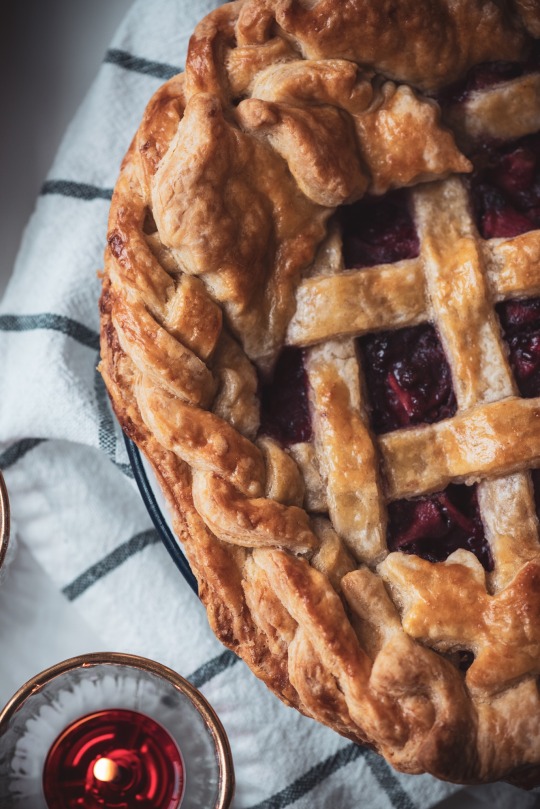
The Autumnal equinox is here! It’s the day where light and darkness are equal, a perfect balance. We are now entering the dark part of the year. It’s time to celebrate the second harvest sabbat. Personally it’s one of my favourite because we can see the shift in Nature. Summer is fading away but there is still lots of green leaves. The air is getting colder but the sun is still hot. I am now preparing my home for the winter to come. I decluttered all my closets and donated every thing I didn’t needed anymore. There is still plenty of fruits to make jams and preserves as well
On this day of celebrations, I am giving you this amazing Apple Pie recipe. It requires a bit of work but it is totally worth it, I promise! Funny story, it’s the first time I am baking a pie, I’ve never had pies before, it not really custom where I grew up. I was curious so I decided toggle it a go. I had to do it 3 times with small adjustments every time and now I am really satisfied of the result, and now I am really convinced that it is one of my favourite fruit desserts!
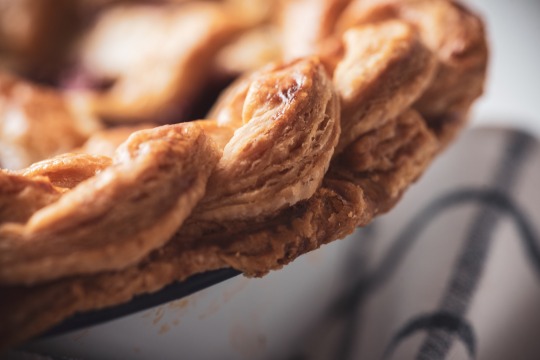
Time
Preparation: 30 min the day before (the dough) + 1h30 (making the pie)
Cooking: 1h
Cooling down: 45min
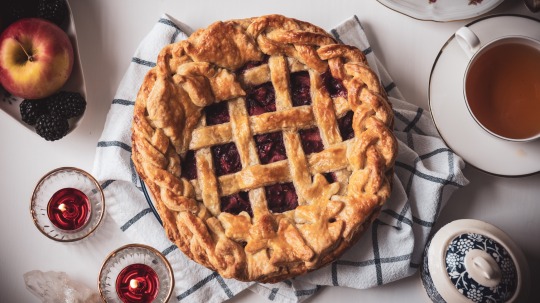
Ingredients
Pie dough
If you want to just a single crust pire, you’ll have to divide the quantities by 2.
330g all purpose flour
1 tsp salt
3tbsp sugar
230g butter (must be very cold) cut into 1cm cubes
120mL iced water approximately
Filling
4 apples peeled, cored and cut into thin strips
200g blackberries, lightly crushed
2tbsp whisky (I recommend a sweet one, not too smoky for a light flavour. I used Glenmorangie)
3tbsp light brown sugar
1tbsp grounded cinnamon
1tsp all spices
1/2tsp clove
1/2 tsp nutmeg
40g flour
3tbsp Salted Maple Caramel (I used this recipe here https://bromabakery.com/salted-maple-caramel-recipe/ ) If you don’t want to do this recipe, any caramel spread will do.
1 egg beaten for the egg wash
Preparation
Pie dough
Make the day before
In a large bowl combine sugar, salt and flour
Add the butter. Mix to cover the butter cubes with flour (it keeps them cold longer). Rub butter into flour until it is the size of walnut halves.
Make a well in the center and add the water a few tablespoons at a time and mix lightly until the dough comes together (don’t over do it)
Wrap the dough in plastic and let it rest in the fridge for the night. This step is really important because a very cold dough will be extra flaky!
Filling
In a large bowl, mix together apples, blackberries, whisky, sugar, cinnamon, all spices, clove, and nutmeg.
Let it rest during the next step.
Making the pie.
Pre heat your oven 190°C / 375°F
Lightly grease your pie pan with butter then dust it with flour (your pie will not stick to the pan in this case)
Divide the dough in 2 balls.
Put one ball back in the fridge
Roll out the other ball in a disk. It has to be large enough that it will recover your pan and drape over the edges of it. Gently fit the disk onto your pie plate by patting the edges of the pan.
With a fork make some holes in the dough
Filter your filling through a colander to separate as much as juice than you can. Now add the caramel, and the flour, mix well. The fruits have to be coated by the flour and the caramel.
Don’t throw away the juice, it is delicious to drink with black tea
Pour the filling into the pie pan.
Let the pie rest in the fridge while you are doing the next step.
Decorating the pie
Roll out the second ball of dough, then cut thin strips about 1 cm wide.
Use them to create a lattice pattern on the top of your prepared filling.
You can make braids and lie them around the edges of the pie. You can also use cookie cutter to add fun shapes, let your creativity guide you!
There is tons of amazing inspirations on Pinterest and Instagram if you need it!
When your design is done, brush the pie with the egg wash.
Bake for an hour at 190°C / 375°F.
IMPORTANT! Check the pie regularly and if it becomes too brown, cover it with an aluminum foil. I usually have to do it after 35-40 min of baking.
2K notes
·
View notes
Text
stop everything, this is bitty doing research for his thesis
there’s more lmao, unhinged bitty energy
240K notes
·
View notes
Text
Localizing Your Practice

So much witchcraft emphasizes how important it is to honor and work with the Earth, but then teaches us spells with ingredients we basically have to import using locations we don’t have access to. It’s rare to find an existing grimoire or guide book that actually works with where we live. We can still use them, but it doesn’t enhance our connection to our local land, which to many can feel important. Here are some tips for localizing your practice and working with the land you actually live on.
See what nature exists around you. Explore your own backyard with a critical eye. What plants can you actually go and pick yourself? What are those plants associated with? Do you have access to a creek or river? What does your local land actually have on it? If magic correspondences for your local plants haven’t been written about, you may have to do your own research. Example: I grow several plants on my back porch which I can potentially use for magic.There are magnolia trees and rhodedendrons on the grounds of my apartment complex. My parent’s neighbors have chickens in the backyard, so I have access to some feathers when they shed.
Check out local folklore, legends, etc. This is one of my favorite parts, but can also be the hardest. What are the stories of your area, both on a local and cultural scale. Example: A West Virginian may incorporate legends of the Mothman. Everyone says that one building on my old college campus is haunted (and they’re right.) People talk about that liminal-space feeling when you drive down that one road at night.
Find the magic spots. Sometimes the urban legends will tip you off to these (usually in a bad way) but other times you can find them on your own. A place where the energy is just right for some reason. A place you can go to be closer to nature, or a place you could host a ritual if needed. Sometimes it’s just a place where you can feel your mind open a little bit. Example: The shady corner of a public park. The tunnel downtown. That weirdly-perfect circle of trees in the woods behind Wal-Mart.
Meet your land wights. Spirits of the local land. This could be the fair folk, but also house spirits, the spirits of the trees near you, the nature spirits of wherever you are. They’re there. Be good to them and they’ll be good to you! Note: Some spirits and wights will not be interested in working with you, and that’s okay. I generally think it’s good to at least leave a polite offering to just be on general decent terms even if you never work with them more directly beyond that.
Check in with your Seasons. Harvest holidays generally don’t have actual lifestyle importance to most people reading this. The seasonal shifts other people write about may be from a very different climate than yours! Figure out a calendar that works for you. It doesn’t have to be detailed, but something that ties you to the seasons as you actually experience them. I also love working in any fun annual festivals nearby, if any.
8K notes
·
View notes
Text

"Since man cannot live without miracles, he will provide himself with miracles of his own making. He will believe in witchcraft and sorcery, even though he may otherwise be a heretic, an atheist, and a rebel."
33 notes
·
View notes
Note
Hey I’m interested in the ins and outs of the Bucca but to be entirely honest I can’t make heads or tails of much of the literature around them. Is Bucca Dhu the same as Odin and is the Grand Bucca the same as Baphomet? Sorry if I sound a little rude.
Hello there.
You don’t sound rude, however, that is more complex of a question to answer than it may initially seem. For, you see, much of the information out there on Bucca is, in fact, quite varied. As such, it can be confusing to sift through for many people.
It would seem, from what I can tell, that your main points of reference when it comes to the figure of Bucca are the writings of Gemma Gary, so I’m going to start by trying to answer your question, framed in the context of the Craft as practiced by Gary and the coven of ‘Ros an Bucca.’ However, I feel compelled to follow that up with some broader historical/folkloric information on this mysterious spirit since, as I mentioned before, it seems like a lot of people are curious and confused when it comes to him. So without further ado, here is my impromptu essay…
Bucca & His Role in the Modern Craft
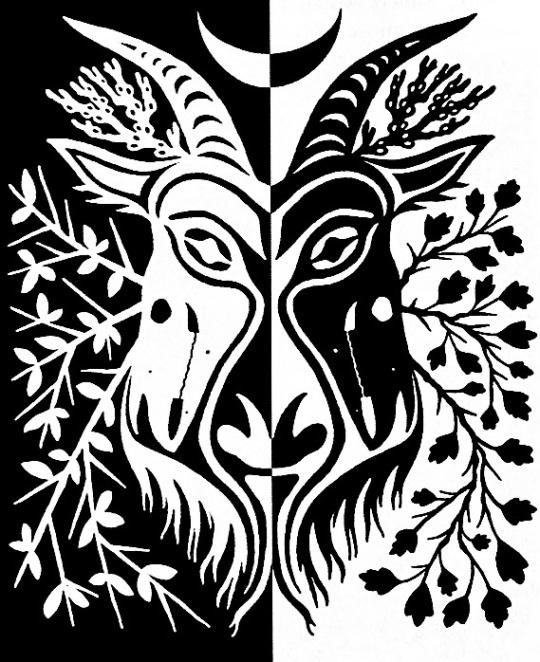
In many iterations and interpretations of the occultic arts, often categorized loosely as ‘modern traditional witchcraft,’ a deific figure frequently called 'The Horned One'—amongst innumerable similar titles—is regarded as the principal Witching God of a given tradition, as well as the chief initiator of the Cunning Flame itself. It is a commonly embraced belief within most currents of practice that tend to fall under this banner of ‘traditional witchcraft,’ that in Old Britain, the god of rural witches was often referred to as 'Devil'. It is ostensibly for this reason that this is still the case for many traditionally based practitioners in the surrounding areas, including the Crafters of Cornwall.
The Devil of the modern traditional witchcraft is, of course, rarely equated directly with Satan as he is depicted in Abrahamic faiths, but is instead regarded, as Gemma Gary puts it,
“an old chthonic folk-god of the land mysteries and seasonal changes (particularly the Autumn and Winter months), weather (particularly storms), death mysteries and the unseen forces and gnosis of use to witchcraft.” She likewise states that “To traditional witches and Cunning folk in Cornwall, in particular the Penwith region, the old Horned One is known as Bucca, and in West Devon as Buckie.” (‘Traditional Witchcraft: A Cornish Book of Ways’, pg. 77, by Gemma Gary)
One aspect of the Bucca found in Cornish lore, and embraced within the paradigm of Gary’s practice, is that he emanates into the dichotomy of ‘Bucca Gwidder’ and ‘Bucca Dhu’—otherwise known the ‘White God’ and the ‘Black God.’ Bucca Dhu is generally seen as the Devil of the previously discussed rural British folk-belief, and is associated with storms, darkness, and the winter months. Conversely, Bucca Gwidder is generally associated with fair weather, light, and the summer months. As is the case in many other, similar spiritual paradigms, Bucca Gwidder and Bucca Dhu dualistically embody the opposing forces of nature. They are intimately tied to one another, with one always giving rise to the other in an infinite cycle of death and rebirth. What’s more, while I can’t seem to find historical evidence for it at this point, Gemma Gary and the coven of Ros an Bucca venerate a mystic triplicity as well, in the form of a ‘conjoined’ Bucca, known as ‘Bucca Gam’, or the ‘Grand Bucca’. This union of opposing forces is said to result in the embodiment of an ‘Androgyne of the Wise’, a concept which mirrors the attainment of the Alchemical Magnum Opus—also called the Rebis (‘Double Matter’), or ‘Divine Hermaphrodite’—which was frequently identified with the attainment of complete wisdom. According to Gary,
“The Grand Bucca and the great Horned Androgyne, the Sabbatic Goat and Goddess-God of the witch-way. For some the Grand Bucca is simply referred to as Bucca, being the whole, with the two opposing aspects of that whole being given the distinction of Bucca Gwidder and Bucca Dhu. In Bucca we find the resolving of all opposites, the traditional candle betwixt the horns symbolising the light of All-Wisdom', and the mystic state of "One-pointedness' which is the ultimate goal of the witch and is the light that illumines the Cunning Path.” (‘Traditional Witchcraft: A Cornish Book of Ways’, pg. 84, by Gemma Gary)

Regarding the connections between Bucca Gam and Baphomet, I think it largely comes down to the fact that it’s relatively rare for modern occult practices to acknowledge deities who are explicitly intersex, with the best-known example of the Divine Androgyne being Baphomet—a being invented by Crusaders in order to demonize the Knights Templar, and then eventually taken up and popularized by occultist Eliphas Levi.
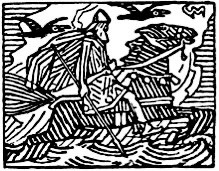
Now, when it comes to the question of syncretic connections between Bucca and Odin/Woden, it primarily comes down to their roles within the concept of the Wild Hunt. As many people know, the Wild Hunt is an important folkloric motif, which describes the shepherding of a ghostly procession across the sky by a powerful mythic figure; in the Germanic world, the leader of this convoy was commonly identified with Odin. Within much of the known Celtic lore, this phantom band was attended and directed by great spectral hounds, known by a wide variety of names. In Cornwall, the Wild Hunt is generally associated with folkloric figures known as the ‘Devil’s Dandy Dogs,’ also called ‘Dando’s Dogs,’ however, it may also be associated with Bucca. As Gary put it,
“On dark and cold nights of winter, Bucca Dhu is also described as riding a great black horse with blazing red eyes and smoky breath. Such lore surrounding Bucca Dhu is cognate with the widespread folk traditions of the Devil and Odin/Woden, as leaders of the Wild Hunt, which in British tradition runs along the Abbot's Way towards Cornwall; the last stop en route to the Otherworld.”
I am yet to come across anything in the folkloric record that matches these particular details, however, it would seem that there is some traditional connection there. For instance, Bucca does demonstrate characteristics of the Wild Hunt in certain versions of the classic Cornish play “Duffy and the Devil” (sometimes called “Duffy and the Bucca”.) This link to Odin is further cemented by the fact that Bucca Dhu is demonstrably connected to the Devil in Cornwall, and the Devil is sometimes said to lead the Wild Hunt, creating an archetypal framework within which both Odin and Bucca fit.
Now for the historical/folkloric background I promised…

According to most relevant sources, Bucca was traditionally described as a form of male Sea Spirit who inhabited coastal communities and their mines during storms—often in the form of a sort of hobgoblin. Many agree that the origins of the Bucca likely relate to faery beings such as the Pwca, Púca, and Puck of Welsh, Irish, and English folklore, respectively, though he also seems to share characteristics with the mermaids of Welsh and Breton mythology—known variably as Morgens, Morgans, or Mari-Morgans.
In one folktale, loosely known as ‘The Sea Bucca of Lamorna’, Bucca was a lonely creature who had once been a human prince, before being cursed by a witch. He was described as having the dark brown skin of a conger eel and a mass of seaweed for hair, as well as a penchant for swimming in the open waves, sitting among the rocks, and/or resting in hidden sea caverns. He was fond of children and assisted the Lamorna fishermen by driving fish and crabs into their nets and pots, but he was capable of terrible retribution, so they generally kept their distance, but left a part of their catch on the beach in order to mollify him.
However, it’s clear that many accounts on the matter clearly speak of the Bucca as more than simply a faery, or sea creature. As Cornish folklorist William Bottrell put it in his 1870 work ‘Traditions and Hearthside Stories of West Cornwall’
“It is uncertain whether Bucka can be regarded as one of the fairy tribe; Old people, within my remembrance, spoke of a Bucka Gwidden and a Bucka Dhu – by the former they meant good spirit, and by the latter an evil one, now known as Bucka boo.”
In keeping with Bottrell's account of the Bucca , a number of folkloric sources make note of Bucca’s manifold nature, referencing the existence of a ‘Bucca Gwydden/Gwydder’ (White Bucca) and ‘Bucca Dhu’ (Black Bucca). Each of these accounts agrees upon the respective benevolent and malevolent natures of these incarnations, though it’s interesting to note that there are considerably more reports of Bucca Dhu, or ‘Bucca Boo,’ than there are of Bucca Gwydder.
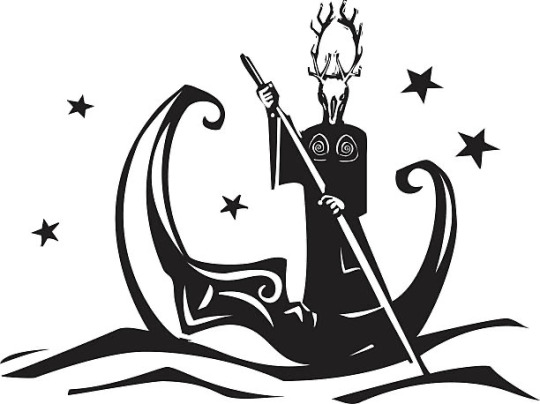
A 19th Century author on Cornish antiquities, named Rev W. S. Lach-Szyrma, proposed Bucca to be the cultural remnant of an ancient pagan Marine Deity once worshiped in the area, such as the British Nodens or the Irish Nechtans. While claims such as these are primarily conjecture, folkloric records do make note of food being left out on the beaches of the region as votive offerings. In the 19th century, for instance, there were reports of fishermen venerating Bucca with offerings of fish, which were left for the enigmatic Wight upon the shores of multiple local beaches. One of these beaches, particularly well known for its use as a site of propitiation, was located near the Cornish town of Newlyn, known formerly as Park an Grouse (Cornish for 'the field of the cross',) where a stone cross was said to once have stood.
These accounts, in turn, bear a certain resemblance to reports of offerings provided to the subterranean Knockers of the region, and as such, may signify some form of cultural continuity of pre-Christian Brythonic traditions. In keeping with this theme of the ‘Mine Faery’, it’s also worth noting that Bucca was sometimes described as a tin-mining spirit as well.
However, Bucca has additionally been historically associated with storms, and in particular, with the wind, which was said to carry his voice across the sea in parts of the West Country. In fact, in Penzance, it was once considered normal to refer to storms that came out of the Southwest as 'Bucca Calling.' For this reason, among others, it is possible that Bucca would have been more properly labeled a weather deity, as opposed to a deity of the sea itself—a distinction that Gemma Gary endorses enthusiastically in ‘A Cornish Book of Ways.’
In Jaqueline Simpson’s ‘A Dictionary of Celtic Mythology’, these marine, tempestuous, subterranean, and pastoral themes are tied together when it’s stated that
“In Cornwall, [Bucca] was ‘a spirit it was once thought necessary to propitiate’; fishermen, tin-miners, and harvesters would deliberately leave a few scraps of their food for him, and spill a few drops of beer.
Children were told to stop crying, or the bucca-boo would come and carry them off.
Some said there were two buccas, one white and kindly, the other black and dangerous.
Fishermen applied the name to a sea goblin of some sort, causing a 19th-century vicar [Lach-Szyrma] to refer to the bucca-boo as ‘the storm-god of the old Cornish’.”

The origins of Bucca’s association with the devil are murky, but they probably have something to do with the widespread equation of faeries with devils in early modern Britain. This doesn’t exactly account for the Bucca’s role as Witch-Father in traditionalist Cornish witchcraft, but those origins are also somewhat murky. It would seem that, at least on the historical record, this particular role was only truly appointed to Bucca around the time of Ros an Bucca’s formation. This isn’t to say, of course, that there weren’t a quiet few who venerated Bucca ongoingly in Cornwall, but given the inherently cultic nature of most covens, this simply isn’t verifiable. However, W.S. Lach-Szyrma’s assertions regarding Bucca as “storm god of the old Cornish” do make explicit reference to the ties between Bucca and the Devil, such as in his 1884 ‘Newlyn and its Piers,’ where he wrote that in the Middle Ages, Bucca was “represented as the Devil.” This syncretism is also briefly highlighted in Margaret Ann Courtney’s 1890 book ‘Cornish Feasts and Folk-lore’, when it’s explained that
“In the adjacent parish of Newlyn, a fishing village, the favourite resort of artists, a great deal of gossiping on summer evenings goes on around the small wells (here called peeths) [. . .] Opposite one of these wells, towering over St. Peter’s church, is a striking pile of rocks, “Tolcarn.” On the summit are some curious markings in the stones, which, when a child, I was told were the devil’s footprints; but the following legend, which I give on the authority of the Rev.W. S. Lach-Szyrma, Vicar of St. Peter’s, is quite new to me:—
‘The summit of the rock is reticulated with curious veins of elvan [quartz-porphyry], about which a quaint Cornish legend relates that the Bucca-boo, or storm-god of the old Cornish, once stole the fishermens’ net. Being pursued by Paul choir, who sang the Creed, he flew to the top of Paul hill and thence over the Coombe to Tolcarn, where he turned the nets into stone.’”

With all of these variable, sometimes even conflicting, accounts of who and what the Bucca is, it's really not a shock that many people find themselves feeling lost when it comes to understanding him, but I hope that this can help to elucidate the subject for some. Resources on the subject are sparse, but they do exist, and a fascinating patchwork of historical and modern perspectives begins to reveal itself if you look for it. Yet, like most things in life, his identity will continue to unfold, shift, and evolve over the years to come.
—
Art Credits (In Order of Appearance):
‘Traditional Witchcraft: A Cornish Book of Ways’ —Gemma Gary
‘Dogme et Rituel de la Haute Magie’ — Éliphas Lévi
Odin Woodcut by Gerhard Munthe (1849-1929)
‘Faeries’ — Brian Froud and Alan Lee
Internet Clipart — Unknown Artist
‘The History of Witches and Wizards’ (1720)
‘Robin Good-Fellow, His Mad Pranks and Merry Jests.’ (1639)
579 notes
·
View notes
Text
Thirteen Arts of Witchcraft
Abjuration - The ability to ward, shield, and forbid.
Compulsion- The ability to impose one's will on another
Conjuration - The ability to summon object, people, and spirits.
Divination - The ability to read signs, omens, cards, lots, etc.
Enchantment - The ability to bestow magical effects on a person, place, or thing.
Evocation - The ability to call forth and bind spirits or entities.
Glamour - The ability to alter the perceptions of others.
Invocation - The ability to claim a spirits power for oneself.
Healing - The ability to restore health or integrity to a person, place, or thing.
Hexcraft - The ability to bend luck for good or ill.
Shining Tongue - The ability to alter the world through words alone.
Spirit-Flight - The ability to fly, walk, move, and shapeshift without the physical body.
Weather Work - The ability to manipulate the weather and natural forces.
224 notes
·
View notes
Text
The Witch's Hand
A witches hands are a conduit for their casting power. The position of the hands in a witch's work will assist them well when employed properly, depending upon the intent.
When the witch desires to conjure forth the power of the wind, the sea, or the weather, the hands should be open, with the palms to the sky in a gesture of request and humility. In such operations, the knife or staff may be well employed. This gesture is also one of welcome and invitation, opening one to the spirits and presences of a space. In rituals where a grand address to all, seen and unseen, is required, this gesture will serve the witch well. This gesture may be paired well with the slow and purposeful raising of the arms, signifying a need for growth in whatever the witch may conjure.
If the witch should desire to lay a blessing or a curse, or when empowering a charm or object, the hands should be kept above the object or person, open, with the palms to the ground or directly facing that which is to receive the blessing or power. This gesture is perhaps the most common in everyday practice, being most useful in many forms of spellcraft.
Another common gesture is to create the shape of the triangle through touching the thumbs and forefingers together. Through the forming of the triangle, we invoke the power of spirit into force into form - the "power of three," or the power of the phases of magical workings. Through the open space in the palms can breathe be blown, water poured, or smoke allowed to float up to the heavens, all while the witch speaks their spells.
As with the positions of the hands, each finger upon the hand may also serve a magical purpose.
The first finger, the thumb, it a most versatile digit. An opposable thumb gives us much of our ability to open, close, and maneuver nearly everything with which we come into contact. It is of great use not only in anointing tools, objects, and other practitioners in blessing, but in quite literally holding a victim under our thumb.
The second, or pointer finger, is well known as one of dominance, and one by which all things may be pointed out for others to observe. It may be used to direct spirits and powers according to the practitioners own will, or to command any which the pointed finger may single out.
The third, or middle finger, often considered highly rude in many settings, is well employed by the witch in the directing of malice. The revealing of the middle finger has been an insult for a great many years, having origins in the French and English war, wherein archers who were captured by the French had their middle fingers removed. Those who escaped intact showed their middle finger as a way of very literally saying that the individual had escaped, and would do everything in their power to see their adversary undone. The showing of the middle finger may be so used by a witch in an act of cursing, blasting, or turning as they will.
The fourth, or ring finger, may assist the practitioner in all matters of love and peace. The ring finger is one upon which physical vows are placed, from one individual to another, in marriage ceremonies. It was once believed that blood from the heart flowed directly through the fourth finger, hence the reason for the placement of the ring. The witch may use this finger in the enchantment of crystal goblets, the creation of love potions, or simple manipulation by touch.
The fifth finger, or pinky, is the weakest finger on the hand, and may not move completely independent of the fourth finger. This little finger may be the conduit for spreading weakness, decay, and more.
Regardless of the chosen gesture, the witch should bear in mind the virtues associated with each hand when working with the gestures. A blessing will best be laid with the right hand, while a curse best laid with the left. An act of removing, or undoing will be conversely performed with the left hand, while any act of casting will be best undertaken with the right. Working with both hands equally teaches the practitioner that there is no giving without taking, and no taking without giving. All is kept in balance.
Right above, left hand below, and you will reap the things you sow.
147 notes
·
View notes
Text
Divination Oil Recipe:
Olive oil
Bay leaves - success and victory
Peppermint - psychic empowerment, get through someone's shields
Angelica root - break through obstacles
Orris root - general empowerment, domination, make others give you what you want (make them let their shields down)
Lavender - psychic empowerment, calming, lulling
Mix these herbs into the oil and set it on your altar for a full lunar month before use
For @magicandbaddecisions and @hallstatt-galno since you guys asked
Uses
Apply to crown and third eye for general boost in psychic abilities, or before doing divination
Mix with alcohol to make a perfume to spray in the room you do divination in
Anoint your tools with the oil or spray with the perfume you make
Put it in an oil diffuser or oil lamp to light during divination
Put some on your dryer sheet/dryer ball so it infuses whatever article of clothing you like to wear or your altar cloth with it
Anoint a candle with it to burn during divination
I'm sure there are other applications as well, but these are the ways I use it! I hope this helps with ideas!
155 notes
·
View notes
Text
“I’ve been a massage therapist for many years, now. I know what people look like. People have been undressing for me for a long time. I know what you look like: a glance at you, and I can picture pretty well what you’d look like on my table. Let’s start here with what nobody looks like: nobody looks like the people in magazines or movies. Not even models. Nobody. Lean people have a kind of rawboned, unfinished look about them that is very appealing. But they don’t have plump round breasts and plump round asses. You have plump round breasts and a plump round ass, you have a plump round belly and plump round thighs as well. That’s how it works. And that’s very appealing too. Woman have cellulite. All of them. It’s dimply and cute. It’s not a defect. It’s not a health problem. It’s the natural consequence of not consisting of photoshopped pixels, and not having emerged from an airbrush. Men have silly buttocks. Well, if most of your clients are women, anyway. You come to male buttocks and you say – what, this is it? They’re kind of scrawny and the tissue is jumpy because it’s unpadded; you have to dial back the pressure, or they’ll yelp. Adults sag. It doesn’t matter how fit they are. Every decade, an adult sags a little more. All of the tissue hangs a little looser. They wrinkle, too. I don’t know who put about the rumor that just old people wrinkle. You start wrinkling when you start sagging, as soon as you’re all grown up, and the process goes its merry way as long as you live. Which is hopefully a long, long time, right? Everybody on a massage table is beautiful. There are really no exceptions to this rule. At that first long sigh, at that first thought that “I can stop hanging on now, I’m safe” – a luminosity, a glow, begins. Within a few minutes the whole body is radiant with it. It suffuses the room: it suffuses the massage therapist too. People talk about massage therapists being caretakers, and I suppose we are: we like to look after people, and we’re easily moved to tenderness. But to let you in on a secret: I’m in it for the glow. I’ll tell you what people look like, really: they look like flames. Or like the stars, on a clear night in the wilderness.”
— What People Really Look Like
156K notes
·
View notes
Text
"White candle can substitute any candle."
No. It cannot. And I'm going to give you one reason why not, and why this whole nonsense needs to stop.
For some cultures, like the one I'm from, white is the color of death. In my culture, white flowers and white candles are used for funerals and mourning, and you wear white flowers and light white candles for the dead.
Do I have a white candle that I use for specific purposes? Yes. But do I use it for everything? No! Because in my world, that is basically equivalent to wishing death upon everything and everyone I light a candle for!
Nothing is a substitute for everything. I'm not even looking for an argument on this one.
1K notes
·
View notes
Text
a witch’s palm.
palmistry placements that may indicate certain natural traits or abilities related to witchcraft.
the mystic cross. “x” shaped cross located between the head and heart lines. indicates that spirituality, witch’s intuition, and acknowledgement of power or ability were understood at a very young age.

the psychic cross. “x” shaped cross located beneath:
the index finger: blessings from jupiter/zeus. wisdom, and a great capacity for knowledge. often destined to teach or impart.
the middle finger: blessings from saturn/cronus. intuition, and a great capacity for visceral power. often has natural ability working in dreams and meditations.
the ring finger: blessings from sun/apollo. attraction, and a great ability to naturally draw in your needs and desires. often powerful with enchantments.
the little finger: blessings from mercury/hermes. instinct, and a great natural ability for practice. often adopts new methods with ease and natural talent.

the psychic triangle. triangular shape located beneath the ring finger. indicates that in this life, or another, you have chosen to suppress your abilities. they are likely powerful, but potentially caused harm- intentionally, or not. (this does not mean they are unreachable, it more likely encourages you to work very consciously.)

the healer’s mark. a series of parallel lines located beneath the little finger. indicates powerful healing abilities; the more lines, the greater the gift.
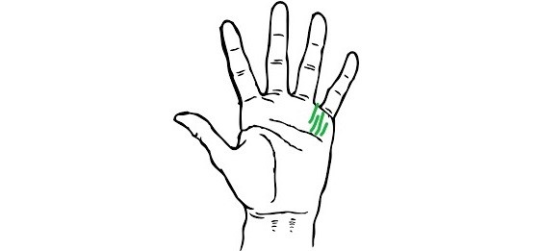
the traveller’s mark. a series of parallel lines located beneath the mount of the moon. indicates that there is an innate talent and drive in travelling both the physical and the astral planes. a natural ability for astral projection; the more lines, the greater the gift.
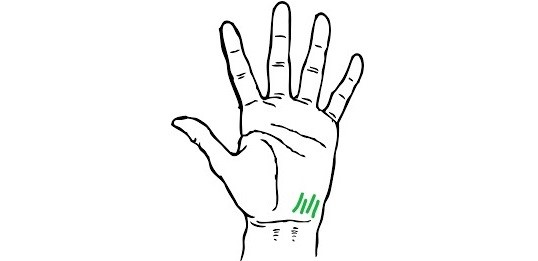
49K notes
·
View notes
Text
🍒 Cherries In Witchcraft 🍒
Gender: Feminine (traditional western European magickal gender)
Elements: Water, Fire, Air
Planets: Venus
Zodiac: Aquarius, Aries
Deities: Morrigan, Artemis, Persephone, Ares, Herne, Aphrodite, Mars, Pan, Thor, Vertumnus, Yaya Zurkurai
Magickal Uses: Love, sex, playfulness, psychic energy and abilities, divination, creativity, sensitivity, money, luck, inner peace, healing, youthfulness, innocence, fertility, sweetness, femininity, emotions, spirituality, friendship, dreams, beauty, relationships, glamours
Magickal Info
It is believed that the best time to use cherry wood or any part of the cherry tree for spells is on the day of Venus (Friday) during the hour of Venus for the best results.
Cherry stones (the pits/seeds) have been used as talismans to attract love. According to Tess Whitehurst, author of You Are Magical and The Magic of Trees, cherry blossoms are for divine love, forgiveness, gentleness, remembering one's primal innocence, romance, and weight loss.
Any part of the cherry tree can be used for spell work and for incense making (bark), oils, sachets, witch bottles, poppets, and the branches are well-suited to becoming magic wands. Cherry wands are best for healing and love spells/rituals.
There is a simple Japanese love spell- the practice of tying a single strand of hair to a blossoming cherry tree to attract love.
Cherry pits have been used in the practice of discernment and foretelling, and its energy can be tapped into for psychic pursuits.
Cherry juice can sometimes be used as a substitute for blood in rituals and magickal workings, and the fruit can be used in place of meat.
The pits can be used in spells for repelling unwanted attention and cause the target to suffer from sickness like nausea and headaches, or something worse if they refuse to go away.
To find out how many years you will live, run around a tree full of ripe cherries, then shake it. The number of cherries that fall represents the number of years left.
Other Info
The cherry blossom was considered sacred to the Japanese emperor.
In 1885 Eliza Ruhamah Scidmore of the U.S., a travel writer and photographer, began working with the Japanese government to arrange for cherry trees to be planted along the Potomac River in Washington D.C. After years of negotiations the people of Tokyo donated 3,000 cherry trees to the people of Washington. On March 27, 1912, Helen Taft (wife of the U.S. president) and Viscountess Chinda (wife of the Japanese Ambassador) planted the first two cherry trees. Approximately 150 of the original 1912 trees, including the first two planted, are still alive.
Eating cherries can increase sexual energy and enhance fertility.
American colonists mixed cherry juice with rum to make a bitter cordial called Cherry Bounce.
In Highland folklore, wild cherry trees had mysterious qualities, and to encounter one was considered auspicious and fateful. In fact, in the Highlands it was once taboo to use cherry wood, as cherry trees were regarded as being so magickal in the culture. They were also a bit rarer in the Scottish Highlands as the cherry tree grows best in the more southerly regions of the UK.
Even to this day many cold and cough remedies use cherry bark to silence coughs due to colds and to help expel phlegm.
Traditional Chinese herbalists viewed cherry's energy and characteristics as being warm and sweet, and as a fruit it is the emblem of femininity and kindness.
Medicinal properties of cherries: promote healthy eyesight, diuretic, increase appetite, anti-inflammatory, cough and cold relief
Been a while since I shared anything on here, so here's some info I gathered and put together a little while ago on using cherries in witchcraft!
165 notes
·
View notes
